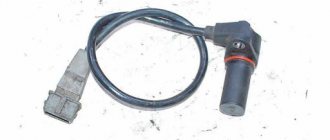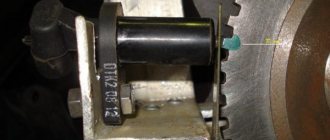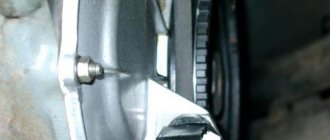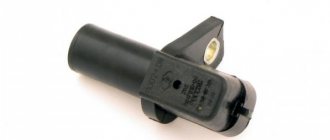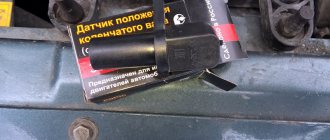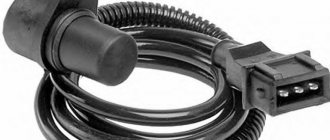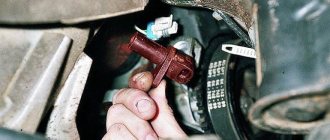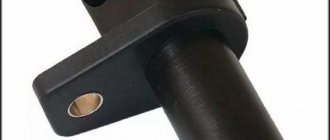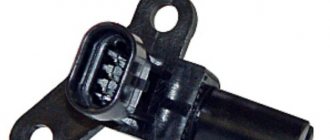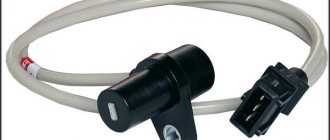Now it's time to change the DPKV. In theory, there is no particular point in making such an entry, but the Internet is replete with a lot of “symptoms”, at the same time, for some reason I have never seen the symptoms that manifested themselves in me anywhere. Everything described below will be based on simple facts about the operation of the machine, the maximum that will be used from the equipment is the BC (On-Board Computer). Inside I will insert simple little things in italics, they are needed for reference in order to avoid unnecessary questions.
Brief information
. DPKV is the most important sensor in the system. You simply won't eat without it. When it finally fails, you will have no spark at all. It is thanks to this sensor that the ECU “knows” what position the engine crankshaft is in. Based on this, injection and ignition are calculated. For example. Without a mass air flow sensor, the car will barely drive, it will stall, the idle will disappear, but the car will drive. No temperature sensor either. The motor stalls, not really working. Etc. and so on. But without DPKV it will not work at all. That's why I always have this sensor with me.
Over the entire life of the car, which is almost 11 years and almost 56,000 km. I changed the DPKV 2 times. So I came 3 times. All these replacements were combined with common symptoms. And like a carbon copy. I will try to describe them in as much detail as possible. I will describe them in the order of their appearance, i.e. in the beginning the one that appeared first.
Symptom No. 1
Occasionally, error No. 53 is stored in the ECU memory, the status is accumulated. Visible only by entry in BC.
Symptom No. 2
The error appears more and more often. After starting the engine, the error lamp may light up, but this does not affect the operation of the car in any way. Error 53 is still present and has accumulated status.
Symptom No. 3
The car takes a little longer to start. Those. You have to turn the starter longer, literally 1-2 turns. After startup, error No. 53 is consistently recorded in the ECU. Over time, the symptom progresses.
Symptom No. 4
The car may not start at some point.
After an unsuccessful start, error No. 53 is still accumulated in the ECU memory. The symptom also progresses over time. Read more: Connection diagram for power windows gas 31105
Symptom No. 5
During operation, the engine may begin to shake, rare “misunderstandings” occur, and the engine loses speed. At this moment, CHEK lights up and goes out (the ECU again indicates error No. 53).
To sum it up. DPKV simply starts to work unstable. And during startup, when the speed is low and the voltage on the DPKV magnet is minimal, its malfunction more often manifests itself. No matter how you look at the DPKV magnet, its characteristics deteriorate over time, the readings have a large error, and the DPKV mark, like the rest of the teeth, has instability (clearly visible on an oscilloscope).
I didn't want to wait. And because I noticed that starting the car was accompanied by the inclusion of CHEK and the appearance of a DPKV error, I immediately decided to replace it.
Basically, I had a new DPKV in the trunk. I bought it a relatively long time ago. I don’t remember where and how, I remember that the manufacturer and the DPKV itself arranged for me. But still, I thought that I needed to buy a new one, put it in the trunk, and put the one that was riding with me. But while going shopping I saw the following. DPKV made with a sledgehammer. A lot of sloppy smelting, the wire going into the DPKV is not filled in and moisture can get into the DPKV itself. There is nothing really indicated on the packaging. The magnet is roughly processed and weakly magnetizes. In fact, it should hold the metal very tightly. The pull-out force should be noticeable. In the end, due to lack of time, I decided to install the one that was in the trunk. Here he is.
Site about SUVs UAZ, GAZ, SUV, CUV, crossovers, all-terrain vehicles
To control the fuel supply, the UMZ-4216 engine of Gazelle and Sable cars is equipped with an absolute pressure sensor, a crankshaft position sensor (frequency sensor), a camshaft position sensor (phase sensor), coolant and intake air temperature sensors.
Sensors of the UMZ-4216 engine control system on Gazelle and Sobol cars, switches and relays, designation, placement and purpose.
The fuel supply control system of the UMZ-4216 engine on Gazelle and Sobol cars also uses an oxygen sensor (lybda probe), on the UMZ-4216 Euro-2 engine there is one, it is installed in the engine exhaust system on the exhaust pipe of the muffler in front of the converter. And two oxygen sensors on the UMZ-4216 Euro-3 engine, the second is installed after the converter.
Electrical diagram of the UMZ-4216 engine control system with electronic fuel injection.
Location of sensors for the UMZ-4216 engine control system with electronic fuel injection.
Absolute pressure sensor SIEMENS ATRT SNSR-0239 or A2C53257696.
The sensor is strain gauge, with a built-in air temperature sensor. The sensor is installed in the receiver and is designed to measure the pressure in the receiver, which changes depending on the load, and at the same time determine the temperature of the air entering the engine. The sensor consists of a diaphragm and an electrical circuit that changes its resistance in proportion to the pressure in the receiver.
Crankshaft position sensor - frequency sensor 23.3847 or 406.387060-01.
The sensor is of inductive type, works in tandem with a synchronization disk having 60 teeth, two of which are removed. The cutting of the teeth is a phase mark of the position of the engine crankshaft. The beginning of the 20th tooth of the disk corresponds to TDC of the first or fourth cylinders of the engine. The counting of teeth begins after cutting along the direction of rotation of the crankshaft.
The sensor serves to synchronize the control phases of the system's electrical mechanisms with the operating phases of the engine's gas distribution mechanism. Installed at the front of the engine, on the right, on the flange of the camshaft gear cover. The nominal gap between the end of the sensor and the tooth of the synchronization disk should be in the range of 0.5-1.2 mm. The sensor is connected to the wiring harness using a three-pin socket with a latch.
Camshaft position sensor - phase sensor BOSCH 0 232 103 006 or 406.3847050-01.
Integrated sensor based on the Hall effect (or magnetoresistive effect) with a built-in amplifier - signal conditioner. The sensor works in conjunction with the camshaft marker pin. The center of the camshaft marker pin coincides with the center of the first tooth of the timing disk. The sensor serves to determine the TDC phase (top dead center) of the first cylinder, that is, it allows you to determine the beginning of the next engine rotation cycle.
The sensor is installed in the front of the engine, on the left, on the camshaft gear cover. The nominal gap between the end of the sensor and the marking pin should be in the range of 0.5-1.2 mm. The sensor is connected to the wiring harness using a three-pin socket with a latch.
Throttle position sensor BOSCH DRG-1 0 280 122 001 or 406.1130000-01.
The sensor is a potentiometer with a current collector. Serves to determine the degree and rate of opening of the throttle valve. On the throttle body there are fittings with a diameter of 8 mm for supplying and discharging coolant to heat the throttle device, as well as pipes for connecting the main branch of the crankcase ventilation system and the idle speed regulator.
Checking the serviceability of the throttle position sensor on UMZ-4216 engines.
During operation, the throttle device does not require any maintenance, however, in case of problems in the power system, especially when the engine is unstable in idle mode, you should check the operation of the throttle position sensor. To do this, with the engine off, disconnect the wiring harness block from the plug connector on the specified sensor. A DC source with a voltage of 5+-0.1 V is connected to connector pins 1 (plus) and 2 (minus).
With the throttle valve closed, the output voltage taken from pins 3 (plus) and 2 (minus) should be in the range of 0.26-0.68 Volts; with the throttle valve fully open, the voltage should be 3.97-4.69 Volts. The accuracy class of the voltage measuring device must be at least 1.0. If the voltage deviates from the specified limits by more than 10%, the throttle position sensor must be replaced.
Coolant temperature sensor 234.3828.
It is a sensor with a thermistor element. Serves to monitor the thermal state of the engine. The temperature sensor is installed on the engine coolant pump housing (front). The connection of the temperature sensor to the wiring harness is made using two-pin plug sockets with latches.
Oxygen sensors - lambda probe 25.36889.
To ensure modern Euro-2 and Euro-3 exhaust gas toxicity standards, one (Euro-2) or two (Euro-3) oxygen sensors 25.36889 (lambda probe) are installed in the UMZ-4216 engine exhaust system on Gazelle and Sobol cars. The main sensor is installed in the engine exhaust manifold and is designed to determine the composition of the mixture before the converter. An additional sensor is installed on the converter body, at the exhaust gas outlet, and is designed to determine the composition of the mixture after the converter.
Zirconium oxygen sensors with controlled electrical heating. The oxygen concentration in the exhaust gases is determined. Their signals allow the engine control unit to maintain the required composition of the fuel mixture for the most optimal engine operation. Oxygen sensors have a non-separable design and do not require maintenance. The sensors are connected to the wiring harness using a 6.3 series socket (signal wire) and a two-pin plug with a latch (the posistor sensor heater circuit).
Rough road sensor 28.3855000.
Rough road sensor 28.3855000 piezoelectric. Located on the right, in the direction of travel, frame side member under the air filter. The sensor measures the acceleration that occurs when the vehicle moves on an uneven road. Designed to detect vehicle body vibrations transmitted to the transmission and engine, and take these vibrations into account when identifying misfires.
Knock sensor GT305.
The sensor serves to detect engine detonation and allows the control unit to adjust the ignition timing to eliminate detonation. The sensor is connected to the wiring harness using a two-pin socket with a latch.
Speed sensor AR62.3843, 342.3843, DS-6, YaM2.553.005.
The vehicle speed sensor is based on the Hall effect and is located in the speedometer drive on the gearbox. Designed to measure vehicle speed by the control unit.
Clutch switch 15.3720.
Switch 15.3720 switches the on-board voltage +12 V, as a sign that the clutch is engaged, to the control unit. Located on the clutch pedal bracket. The switch is designed to identify by the control unit the moment the gear is turned on/off to determine the engine operating mode (idling, transmission engaged) and throttle control parameters.
Brake light switch 21.3720.
The brake signal switch 21.3720 is designed to turn on the brake signal lights located in the rear lights, located on the brake pedal bracket.
Relay 90.3747, 85.3747, 313.3747-10.
Electromagnetic relays are located in the engine compartment of the car. The relays are designed to switch the voltage of the vehicle's on-board network upon command from the control unit: the main thing - to the actuators, control system sensors and control unit, the fuel pump - to the electric drive of the submersible electric fuel pump module, the fan clutch - to the electromagnetic clutch of the cooling system fan drive.
Source
Share with your friends:
Purpose and operating principle of DPKV
The function of the device is to determine the position of the engine cardan at a certain time for computer control of actuators and coordination of the functioning of the gas distribution system. It serves to ensure the formation of impulses from the (60-2) teeth of the disk, that is, it marks the rotation of the cardan on sector marks. The angular stroke of one tooth, together with the gap to the next, is equal to 6 o of rotation of the cranked spindle. It functions in conjunction with a toothed circle located on the cardan pulley. The circle has 60 notches with 2 whole protrusions missing. The cutout on the circle serves as the starting point for the location of the crankshaft. The beginning of the 20th (behind the cutout) tooth (teeth numbering starts from the cutout clockwise) corresponds to TDC of the first or fourth cylinder.
The specificity of the action of the crankshaft sensor is the formation of an alternating current emf of a sinusoidal type in its coil when passing a metal tooth of a circle with protrusions near its end. In the middle of the protrusion (its rear cut) there is zero pulse amplitude. When passing the cutout of the gear circle, the device is silent. From this point the car computer starts counting. When the 20th notch of the ECU synchronization circle approaches, it marks the location of the pistons of the first or fourth pots at TDC. Thus, the car computer knows what is located where in the engine.
Failure of the DPKV leads to the engine stopping.
Attention! The crankshaft sensor is the most important sensor among all engine sensors. You need to have a intact, working, spare DPKV in your car.
How to replace DPKV?
To facilitate the disassembly and adjustment procedure or replacement of the controller, a 50-70 cm long wire is connected to it. This line is equipped with special key covers. To adjust the position of the controller, adjust the washer attached to the seat of the device. The procedure for adjusting this washer can be carried out in a workshop or at a service station. Correct adjustment will allow you to avoid rapid breakdown of the aggregate cylinders and reduce fuel consumption.
Algorithm of actions for exchanging controllers:
- The controller is disconnected from voltage; to do this, disconnect the plug using the device's wiring.
- Using a wrench, unscrew the screw that secures the device to the installation site.
- The driver himself has been dismantled.
- An undamaged controller must be placed in its place. The locking device is screwed back. The plug with wires is connected.
- After installing the controller, a gap measurement test must be performed. Pocket between the teeth of the generator drive command and check the regulator core. The TENTETTE kit is used to measure this parameter. The gap size should be between 0.39 and 0.41 mm, preferably 1 mm.
If diagnostics show that the clearance differs from the required value, adjust the position of the controller. Or you need to get rid of existing pollutants. After replacement, start the combustion engine and check for proper operation.
1. Loose fit of valves to seats. Grind the valves to the seats.
2. Burning of exhaust valve chamfers. Grind or replace the valves and then grind them in.
Technical characteristics of the crankshaft sensor 23.3847
This section indicates the location of the crankshaft sensor for engines 405, 406, 409, 4213, 4216. The specific installation point for the device is presented.
It is mounted in the front of the heart of the car, on the right, below on the protrusion of the front cover of the cylinder block. Attached with M6 hardware under head 10. The normal gap between its end and the tooth of the synchronization disk should be 0.5-1.2 mm. For stable operation, set the gap to 0.8 mm. To do this, you need to sand the device seat with sandpaper. The crankshaft sensor is connected to the wiring harness using a three-pin socket with a frame spring.
Where is the DPKV installed on the UMZ 4213, 4216 engine?
The crankshaft sensor is located in the front part of the engine, on the right, on the flange of the camshaft gear cover. The nominal gap between the end of the device and the tooth of the synchronization disk is in the range of 0.51-2 mm.
Dismantling and So
installation, you have determined that the DPKV has left the Therefore. building, there is nothing left but to replace it. To do this, you will have to dismantle the old device.
- Turn off the ignition and open Securely. secure the hood to avoid unpleasant blows to the back or head.
- Remove any dirt from around the sensor so that it can be removed and visually inspected.
- Disconnect the wiring from the block from the corresponding connector.
- Using a 10 mm wrench you can easily dismantle the sensor crankshaft mount.
- Remove the damaged device.
- At the same time, be sure to check the generator drive toothed pulley. Damage rarely appears on it, due to which the device may not work correctly. Because of these teeth, error codes appear on the on-board computer.
- If there are no defects and nothing prevents the installation of a new one, begin assembling the device.
- If necessary, clean the location of the DPKV.
- Place the new measuring socket into the device and tighten the fastening bolt. If this is not exceeded, the tightening torque is more than 12 Nm.
- Be sure to use the adjusting washer, which is already supplied by responsible sensor manufacturers.
- Using a special feeler gauge, make sure that there is a gap of 1 millimeter between the pulley and the DPKV core.
- The error of the gap may be no more than 0.41 millimeters in one direction. In any case, do not make the gap smaller. Maintain 1 mm.
Price issue
As we have already noted, VAZ 2114 owners are not often faced with the need to change the DPKV. But always be prepared for trouble.
You don’t have to spend a lot of money purchasing a new sensor. The price depends on the region and the store where car parts are sold. On average, a recreation center costs about 200-400 rubles.
Engine crankshaft sensor malfunctions
Note: There is a domestic cardan meter on the propulsion unit 409. The UAZ 31602 car ran more than 80,000. There are no complaints about the device. But I set the gap between its end and the sync disk to 0.8-0.9 mm.
Crankshaft position sensor errors
The table form shows the crankshaft sensor errors that are detected by the self-diagnosis of the vehicle's ECU.
| Error codes for electrical synchronization sensor 409.10 with Mikas 7.2: | ||
| Auto engine crankshaft error code 409 | Name of the breakdown | Circumstances of determination |
| 027 | Breakage of the crankshaft position device line | When turning the cardan |
| 028 | Damage to the electrical cardan position sensor network | When twisting the crankshaft |
| 029 | Defective crankshaft position sensor line | When turning the cardan |
| 053 | Broken wires of the electric cardan position sensor | When twisting the crankshaft |
about Briefly self-replacement
So, after diagnosing the sensor and identifying problems with the sensor, the question of replacement arises. And if you really want to do this procedure yourself, then you need to focus on the size of the gap in the gap between the disk core and the synchronization sensor, since for different models the gap has its own shape. The process of removing the old device itself is not difficult at all.
It is impossible to describe it, as there is no unique formula due to the technical characteristics of different cars. And it also wouldn’t hurt to secure the new sensor using the old bolts. This is due to the fact that they will not create unnecessary hesitations or unforeseen ones of their own.
As for the backlash, you can easily adjust the installation depth using a washer. It must be provided in one set with the DPKV.
Sensors DPKV, DPRV(DF), DTOZH, DD.
This post will talk about some sensors installed on the motor itself. About their necessity, installation features. DPKV - crankshaft position sensor.
The crankshaft position sensor is designed to evaluate the rotation speed of the engine crankshaft, determine the position of the crankshaft, and, accordingly, the position of the pistons in the cylinders.
DPRV(DF) - camshaft position sensor.
The phase sensor (PF) is designed for the controller to determine the valve timing for each of the engine cylinders. Advantages of phased injection: 1) Higher accuracy of fuel dosing at idle and low loads when using high-performance injectors. 2) There is no 2nd “lag” (a rather slippery section of the time of transient processes of opening and closing the injector, depending on the characteristics of the injector and the voltage of the on-board network in the car, which can be quite unstable during operation). In addition, this slightly increases the control range when the injectors reach long injection times (80% opening or more). 3) Detonation selection is carried out cylinder-by-cylinder and not in pairs. In principle, engines are not ideal; there may be a slight difference in the combustion chambers, causing single detonation knocks in one of the cylinders when operating at sufficiently early angles. In this case, without a DF, the detonation rebound will spread to 2 cylinders at once, which will lead to some loss of torque by the engine. 4) The ability to set the moment of opening the injector, clearly related to the working processes in the engine.
DTOZH - coolant temperature sensor
The engine coolant temperature sensor monitors the "internal engine temperature". The sensor detects changes in temperature and signals the Electronic Control Unit (ECU) about the state of the engine - the engine is cold, warming up, overheated or operating at normal temperature. The signals that the DTOZh sends to the ECU affect the overall behavior of the engine control system. Engine operating temperature affects many functions. The amount of fuel injected, ignition timing, etc., which are controlled by the ECU. Depending on the engine temperature, its operating mode is selected.
DD - knock sensor.
In an internal combustion engine, under a certain set of circumstances, a metallic knock occurs. “Fingers are knocking,” some drivers say. In fact, this phenomenon is called detonation and its occurrence is extremely undesirable, since it can lead to engine failure due to the enormous speed of propagation of the flame front (more than 2000 m/s) and high shock loads on the cylinder walls, piston and block head. To monitor this phenomenon, a knock sensor is installed on the cylinder block. It continuously sends signals to the electronic engine control unit, and the electronics respond by changing the qualitative composition of the working mixture and the ignition timing. DD also helps to achieve more economical operation and develop maximum engine power.
Well, now directly about installation on the motor.
DPKV
should be well fixed and should not move when the motor is running. The bracket must be made of non-magnetic material. To be honest, I fiddled around quite a bit, we measured it 1000500 times and cut it off to make a bracket like this.
The mounting holes were made oval to accurately set the gap between the sensor and the reference disk.
I made it from an aluminum 45-gauge angle (I couldn’t find a more massive one, and I didn’t buy a 3-meter angle) and three pieces of aluminum tire.
To install the motor bracket, I replaced 2 studs on the front cover with longer ones.
It turned out something like this.
The sensor must be strictly perpendicular in two planes to the disc tooth.
I set the gap to 0.45mm (in the photo the sensor is simply positioned in the planes). According to the Taz Kama Sutra, the gap range between the sensor and the teeth lies within 0.3-0.8 mm. It is important that this gap is constant regardless of the angle of rotation of the pulley. That is, there should be no beating. The runout tolerance is 0.1-0.2mm in my opinion. Later I centered the pulley with a gap of 0.4-0.45mm. The position of the DPKV should be oriented to the center of the 20th tooth, not counting the missing ones, along the crankshaft. In this case, the crankshaft should be at the top dead center of the first cylinder. To do this, after installing the DPKV on the engine, I turned the toothed disk on the pulley. It sits tight on me.
DPRV(DF)
In theory, I don’t need it yet, since the engine will be run in on the carburetor, but the ignition will already be on January 5.1-41. But so as not to bother with installing it later, I decided to do it right away. Let him stand there, don’t ask for anything to eat or drink. DF can be installed in several places. For example, in the distributor, but I completely eradicated it. On the block, to do this you need to place a pin marked in the camshaft. Or another option, like on the UMZ 421, in the front cover on the gear. I decided to install it using the latter option, in the front cover. That is, take the signal from the camshaft gear. To do this, you need to make a marker from magnetic steel. It is better to take a thickness of at least 1mm. I took 1.5mm. The result is a petal like this.
The width of the marker was made according to the width of the sensor, the mounting tip according to the diameter of the camshaft bolt washer.
This is how it sits on the gear.
The gear can, of course, be used from the same UMZ 4216 with a built-in marker, but since the gear is adjustable (split), it is more correct to use a marker that is not fixed to the gear.
To install the sensor on the front cover, 2 stiffening ribs were cut off from it.
Since the sensor has a certain length, to install it you need to make a spacer from a non-magnetic material. I used caprolon. Well, he’s solid =). You'll cut the hell out...
The thickness must be selected in such a way that the sensor protrudes from the cover by about 5mm. I made it 20mm.
I drilled holes in the cover for fastening the spacer and for the sensor.
Next, you need to orient the marker relative to the hole. The marker should be facing the center of the sensor. Rotating the crankshaft, install tooth number 1 of the DPKV reference disk (60-2) opposite the crankshaft position sensor. The intake valve in the first cylinder should be at the end of the intake phase (the cam has passed the pusher - the valve is closing or is already closed). If this is not the case, the crankshaft rotates 1 full revolution (360 degrees). This is all relative to January 5.1. For others it was not specified. Oh yes. The gap was 0.5mm.
We install the spacer on the cover using sealant on the screws, and cut them almost flush with the cover.
This is how the phase sensor will stand on the cover.
Both sensors are in place, oriented and with gaps set =)
DTOZH
placed it in the center of the block head. There are holes for the exhaust gas recirculation (EGR) valve, which was dismantled a long time ago as unnecessary. To install the DTOZH, a coupling will be machined in its place, since the diameter of the holes is different.
Well, let’s screw the whole thing into place.
DD
installed on the top of the block. I screwed an M10-M8 adapter pin into the technological hole opposite the cylinder head stud, between cylinders 3 and 4, since there is an M10 hole in the block and an M8 hole on the sensor.
Let's leave it at that for now. Wait for the continuation... =)
Source
Crankshaft sensor 4216 where is it located?
Now it's time to change the DPKV. In theory, there is no particular point in making such an entry, but the Internet is replete with a lot of “symptoms”, at the same time, for some reason I have never seen the symptoms that manifested themselves in me anywhere. Everything described below will be based on simple facts about the operation of the machine, the maximum that will be used from the equipment is the BC (On-Board Computer). Inside I will insert simple little things in italics, they are needed for reference in order to avoid unnecessary questions.
Brief information
. DPKV is the most important sensor in the system. You simply won't eat without it. When it finally fails, you will have no spark at all. It is thanks to this sensor that the ECU “knows” what position the engine crankshaft is in. Based on this, injection and ignition are calculated. For example. Without a mass air flow sensor, the car will barely drive, it will stall, the idle will disappear, but the car will drive. No temperature sensor either. The motor stalls, not really working. Etc. and so on. But without DPKV it will not work at all. That's why I always have this sensor with me.
Over the entire life of the car, which is almost 11 years and almost 56,000 km. I changed the DPKV 2 times. So I came 3 times. All these replacements were combined with common symptoms. And like a carbon copy. I will try to describe them in as much detail as possible. I will describe them in the order of their appearance, i.e. in the beginning the one that appeared first.
Symptom No. 1
Occasionally, error No. 53 is stored in the ECU memory, the status is accumulated. Visible only by entry in BC.
Symptom No. 2
The error appears more and more often. After starting the engine, the error lamp may light up, but this does not affect the operation of the car in any way. Error 53 is still present and has accumulated status.
Symptom No. 3
The car takes a little longer to start. Those. You have to turn the starter longer, literally 1-2 turns. After startup, error No. 53 is consistently recorded in the ECU. Over time, the symptom progresses.
Symptom No. 4
The car may not start at some point. After an unsuccessful start, error No. 53 is still accumulated in the ECU memory. The symptom also progresses over time.
Symptom No. 5
During operation, the engine may begin to shake, rare “misunderstandings” occur, and the engine loses speed. At this moment, CHEK lights up and goes out (the ECU again indicates error No. 53).
To sum it up. DPKV simply starts to work unstable. And during startup, when the speed is low and the voltage on the DPKV magnet is minimal, its malfunction more often manifests itself. No matter how you look at the DPKV magnet, its characteristics deteriorate over time, the readings have a large error, and the DPKV mark, like the rest of the teeth, has instability (clearly visible on an oscilloscope).
I didn't want to wait. And because I noticed that starting the car was accompanied by the inclusion of CHEK and the appearance of a DPKV error, I immediately decided to replace it.
Basically, I had a new DPKV in the trunk. I bought it a relatively long time ago. I don’t remember where and how, I remember that the manufacturer and the DPKV itself arranged for me. But still, I thought that I needed to buy a new one, put it in the trunk, and put the one that was riding with me. But while going shopping I saw the following. DPKV made with a sledgehammer. A lot of sloppy smelting, the wire going into the DPKV is not filled in and moisture can get into the DPKV itself. There is nothing really indicated on the packaging. The magnet is roughly processed and weakly magnetizes. In fact, it should hold the metal very tightly. The pull-out force should be noticeable. In the end, due to lack of time, I decided to install the one that was in the trunk. Here he is.
limits of motion sensor operation for each
The sensor illumination has a number of parameters, the adjustment of which ensures its correct operation.
tilt angle and height
This parameter is adjusted through the hinges, which are structurally included in the scanning device. The detector beams work in a cone-shaped area. Depending on the angle of inclination changes, the area will be detected. If the detection angle of the cone is too strong, then objects raised at a great distance will not be detected due to the well-insignificant sensitivity, but a blind zone will arise near it. If the angle is all the way down, the detection zone will become smaller.
angle In addition to the tilt, the height and position of the sensor should be correctly positioned. A position below the detection target, human height for example, will cause the detection cone to be directed parallel to the ground. higher The sensitivity, the higher the scanner can be positioned and the angle lower.
Illumination
With this parameter you can determine the level of darkness that is considered working. This parameter is called Settings. LUX motion sensor lighting installation is performed at different brightness levels. They determine the threshold for triggering. This is necessary so that it does not occur in twilight or insufficient lighting conditions. It is best to adjust its time when the threshold value occurs in the evening: brightness before dark.
Sensitivity
This parameter is called SENS on most sensors. It requires that it does not trigger the appearance of small animals. Adjusting this parameter is more difficult than others. The correct value can only be determined by trial and error. It is clear that it is not always clear whether the device triggered when a person passed by or Alone.
of the animal, one of the criteria for the need for its adjustment is too frequent inclusion. If it is not located in a place where people often walk, then this parameter should be reduced. There are also seasonal settings: transitions in winter SENS parameters will require modification in the summer. Outdoor operation may require annual adjustment of this time according to the season change parameter.
Setting by time
TIME The setting is most often determined by a range in minutes from 1 interval to 10. It determines the duration of time during which the sensor should apply current to the load after switching on. It is useful in two cases: if during the watch certain triggering events are too frequent or if necessary for a long time. Second. post-processing case, possible in a dark room, closet, for example. When a person enters it, the light automatically lights up and its operating time is sufficient to pick up the desired item.
Determining crankshaft sensor malfunction
If the engine stops starting, you need to check for spark and power to the injectors. Remove the high-voltage wire from the spark plug and bring it to the engine, and then turn the starter. The absence of a spark indirectly indicates a malfunction of the crankshaft sensor. But you need to be careful, if there is still a spark, a strong discharge of current to the ground of the car can cause failure of the electronic engine control unit.
The pulley must sit tightly on the toe of the crankshaft, and if the key breaks or the ratchet unwinds, the pulley dangles, the signal from the crankshaft sensor is not correct, and the ECU supplies a spark and power to the injectors out of step.
CRANKSHAFT POSITION SENSOR
CRANK POSITION SENSOR Principle
Structurally, the sensor consists of the following elements: a cylindrical plastic or aluminum housing with a sensitive element; sensor base with hole and mounting flange; shielded communication cable 610 mm long; three-pin plug connector, cable on crimped.
installation and installation of the sensor on the vehicle
Analogues of the crankshaft position sensor 3847 23.shaft (Kaluga): synchronization sensor DG-6 0261210113 (sensor); BOSCH synchronization DS-1 406.3847060-01 (Castroma). differences in the design of sensors: for domestic sensors, the cable output is rotated 90 degrees relative to the axis of the sensor mounting hole. For the imported analogue DG-6, the cable outlet is opposite, directed away from the mounting hole.
External fault manifestations of sensor circuits
no comments. Yours will be the first!
How to check the crankshaft sensor yourself.
To do this, you need to remove the sensor from the engine and conduct a visual inspection; there should be no dents or cracks on it. Then you need to check the sensor winding for resistance by connecting a multimeter to the crankshaft sensor terminals.
Then quickly bring a metal object to the crankshaft sensor core; if it is working properly, you will see voltage surges on the device.
crankshaft sensor UMZ 4216 — search on DRIVE2
Hello guys, I'm boiling, I'm tired of changing sensors
phases... In short, due to the low cost, I always bought
sensors
, to be honest, a rare g...o. Over the past 3 months I have changed 5 pieces.
Crankshaft position sensor GAZelle Business
Yesterday evening I started having problems starting. The warmed up engine started on the second or third attempt. There were no longer any options for repairs at 17:00 outside the city, so there was nothing left to do but finish the work and, if possible, move towards the house.
Sensor
The crankshaft
position is flooded again! It's like a curse! Once even after washing
The ECU reports " sensor
crankshaft
position » And how many times did I get up in the spring or
I once went to Umz
so. So there, as if a drop gets on the spark plug caps, that’s it.
P0336 Crankshaft Position Sensor Error
Symptom of a faulty crankshaft sensor
Repair of UMP – 4216…
Sigurdja › Blog › Repair of UMP
–
4216
… Sigurdja last online 2 weeks ago.
the sensor was installed in the upper radiator hose
turn on the fan and set
the sensor
to a temperature of 97°-82°. Connected.
Injecting 417th. (Part 2) - GAZ 21, 2.4 l., 1967
Overhaul of UMZ 4216
Hooray! STARTED... and less than a year has passed! — KIA Sportage, 2.0 l., 2001.
Sensor
synchronization 35.3847 is designed to generate an electrical signal when the angular position of a special toothed disk mounted on the
engine
crankshaft .
The sensor
is used as part of a comprehensive engine control system.
How to check the Crankshaft Position Sensor (CPS)
Sensor
crankshaft position
- all about
the crankshaft
sensor It is very difficult to imagine a modern miracle of engineering - a car without an abundance of electronic systems.
Camshaft and crankshaft sensors ZMZ 406. - Community.
Good day everyone! If with sensors
temperatures and their manufacturers, everything is clear (except for the recommended 405226, there is nothing special to take), then with the above
sensors
I don’t know what to choose, the topic is not discussed, so I turn to the community.
Gazelle error 053. crankshaft position sensor malfunction
Good afternoon everyone. Tell me who is in the subject. Such an incident happened for two days in a row, I drove a gazelle 406 engine and had no complaints about the work. But on the third it didn’t start. When you turn the engine it catches periodically but refuses to work.
Report after updating the UMZ 4216 - GAZ software.
DPKV from Gazelle - Great Wall Hover, 2.0 l., 2014
Measure seven times (crankshaft position sensor) - UAZ 3160.
Ignition system UMZ 4216
The electronic control unit receives reference signals from sensors
crankshaft position and
phases.
The UMZ
4216
ignition system is part of the engine control system and consists of an ignition coil, high-voltage wires, etc.
GAZ Gazelle UMZ 4216
Colleague! Health to you and everything connected with you. I recently rode a Gazelle 3302 farmer 4x4 with a UMZ
4216
injector Euro 3 2012.
Question about the sensor on UMZ 4213; 4216 - Community "UAZ drivers".
I didn’t like UMZ
4216
or
UMZ
motor on
sensor
When will I get married ZMZ-40200M and ZMZ- 4216
and they will install it on the Volga to scribble over this problem.
In the 402, the crankshaft
do not fall out below the belly and therefore the block is more rigid.
